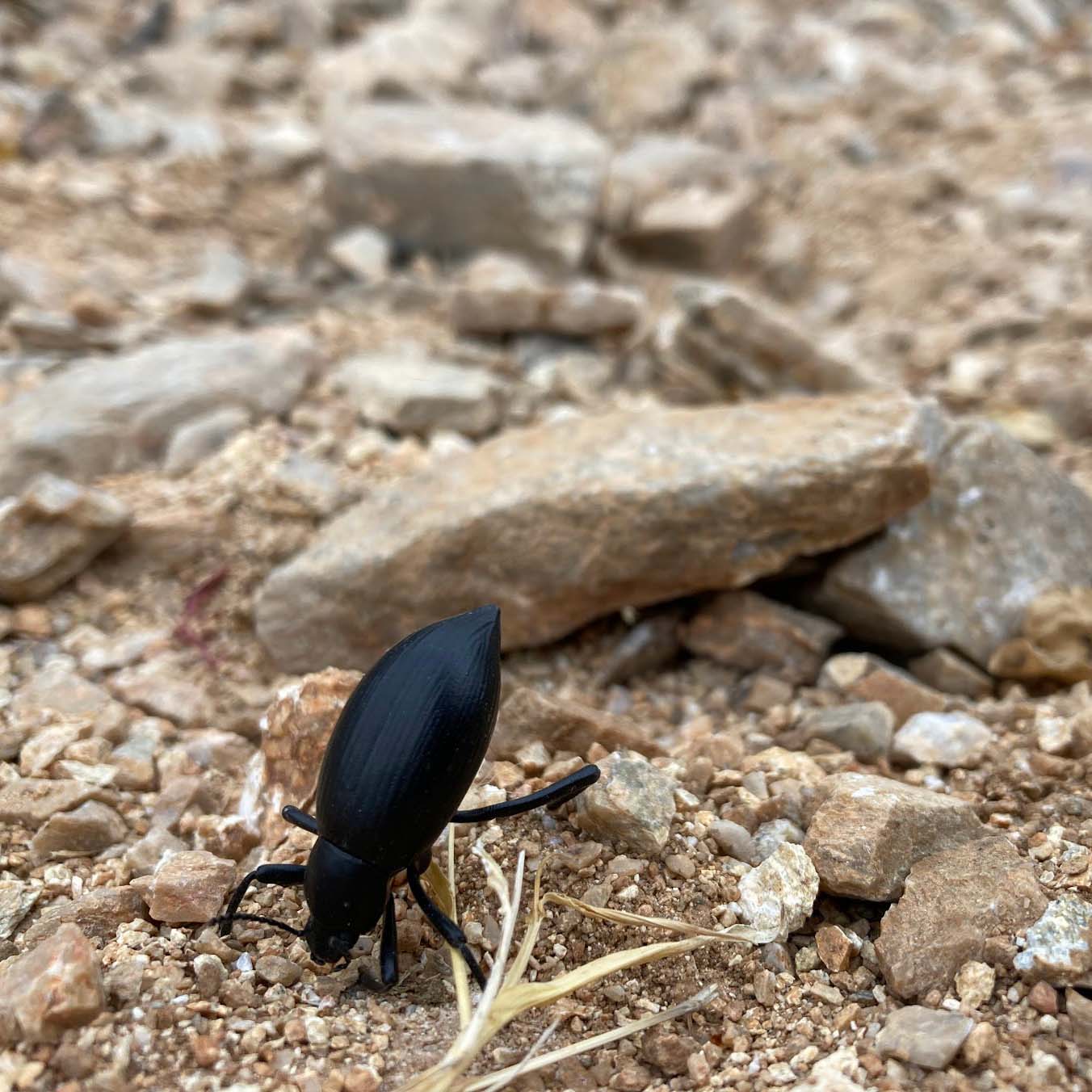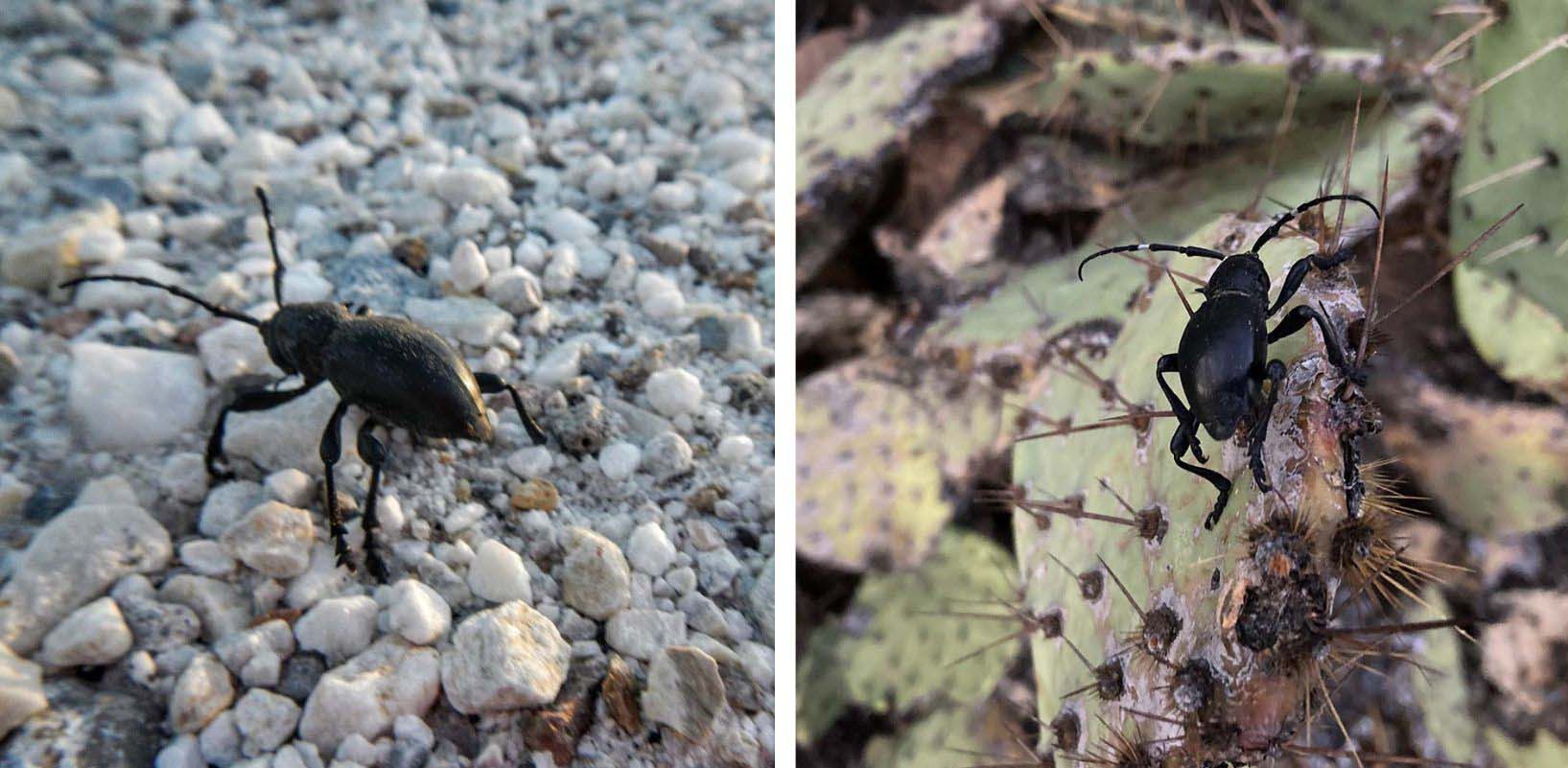
A pinacate beetle assumes a defensive headstand, ready to spray a stinky substance if need be from two anal glands. Photo by Rick Mick/SIA.
With monsoon season underway here in the Sky Islands, beetles are all about. Recently, it got me thinking about one of my favorites, which is in the family of darkling beetles and genus Eleodus. This genus is fascinating, with more than 120 species in North America. Sometimes known as stink beetles or clown beetles, here they’re often called pinacate beetles. The name comes from the Nahuatl word pinacatl, meaning “black beetle.” And it’s often used to refer to all members of the genus in our region.
Pinacate beetles are usually all black, though some species have a reddish tint to their abdomens, making them appear browner overall. They’re also large (up to 1.4 inches long) and oval-shaped, making them rather “olive-like,” which is what Eleodes means. Their abdomens are covered by fused elytra (wing covers) to help them preserve water and protect against predators. But this single hard cover renders them flightless. The elytra can be smooth or covered in rough ridges along their length.
Eleodes beetles are commonly found throughout the year in our deserts and mountains. In the hotter months, they tend to be most active at dusk, dawn, and through the night. But when the weather cools, they can be found wandering throughout the day. Because they can’t fly, they’re usually found as they walk around looking for food, which in their case is typically organic detritus such as fallen leaves or other plant matter, fungi, dead insects, or whatever else they find in their travels.
They would seem to be quite vulnerable, as conspicuous as they are, but this is where a unique aspect of theirs comes into play. When disturbed, they drop their heads to the ground and raise their butt high into the air, doing something like a headstand. As they assume this position, they secrete a smelly and foul-tasting quinone-based liquid from two anal glands. This substance runs down the beetle’s body, making for a very unpleasant meal. Or, in some of the largest species, the substance can be sprayed up to 20 inches at an attacker. If it gets into the eyes or mouth of another animal, it can cause stinging or burning sensations and even temporary blindness.
This defense is so effective that several beetles from other genera are mimics of the pinacate beetles. Perhaps the most effective of these mimics are the cactus longhorn beetles (Moneilema sp.), which not only share the general shape and color of Eleodes beetles, but will even do the headstand display when threatened, even though they have no substance to secrete or spray.

Several unrelated species, including these cactus longhorn beetles, mimic pinacate beetles but lack the same chemical defenses. Photos by Rick Mick/SIA.
Despite the protection afforded to the pinacate beetle by its secretions, there are still predators that manage to make a meal of these beetles. The feisty grasshopper mouse (Onychomys torridus) is known to get around their defenses by grabbing the beetle and shoving its offensive end into the dirt while feasting on the front end. The mouse proceeds to eat almost the entire beetle, stopping just short of the glands at its tail end. Some other predators such as owls, shrikes, foxes and skunks seem to be undeterred by the secretions or have found their own ways around the beetle’s defenses.

Some animals have found their way around pinacate beetles’ defense. Predators include grasshopper mice, owls, and skunks. Photo of grasshopper mouse courtesy NPS; great-horned owl by Miguel Enríquez/SIA; hooded skunk courtesy SIA.
If they can avoid predation, pinacate beetles are long-lived for an insect. Studies of Eleodes armatus have shown that adults can live over a year in the wild. The full potential lifespan of pinacate beetles is yet unknown, but some other darkling beetle species live up to two years as adults. Mating seems to happen throughout the year, at least in captivity. But it’s likely that female pinacate beetles lay their eggs during spring and fall in moist soil. When the larvae hatch, they look a lot like mealworms — which makes sense, since mealworms are also in the darkling beetle family (Tenebrionidae). Lab studies of larval Eleodes beetles have shown that some species require at least nine months to reach adulthood, but not much is known about their development in the wild.
If you’re interested in finding one of these beetles, your best bet is to get out and wander. In the summer months you’re more likely to find them under rocks during the day. But you could check around moist areas, as they’re known to be attracted to damp soil. Otherwise, in the morning, evening, or at night are going to be the best times. Once the monsoons have cooled things off, your chances of finding one during the day will be much improved.
References
- Brummermann, Margarethe. (2021, September 16). Population explosion of the Ground Beetle Calosoma sp. Arizona: Beetles Bugs Birds and more. Arizona: Beetles, Bugs, Birds and more: Population Explosion of the Ground Beetle Calosoma sp. (arizonabeetlesbugsbirdsandmore.blogspot.com)
- Eaton, Eric R., and Kaufman, Kenn. 2007. Kaufman Field Guide to Insects of North America. New York: Houghton Mifflin Company.
- Schalau, Jeff. (2019, July 3). Pinacate Beetles. Backyard Gardener. Backyard Gardener – Pinacate Beetles – July 3, 2019 (arizona.edu)
- Thomas, Donald B. (1984). The Life History and Ecology of the Pinacate Beetle, Eleodes armatus Leconte (Tenebrionidae). The Coleopterists Bulletin, 38(2), 150-159. The Life History and Ecology of the Pinacate Beetle, Eleodes armatus Leconte (Tenebrionidae) (arizona.edu)
- Wikipedia contributors. (2018, July 6). Eleodes. Wikipedia, The Free Encyclopedia. Retrieved July 6, 2023, 12:20 UTC, from https://en.wikipedia.org/w/index.php?title=Eleodes&oldid=1163777810.
- Williams, David B. (n.d.). Pinacate Beetles: Stinkbugs. DesertUSA. Retrieved July 6, 2023, from Pinacate Beetles – stinkbugs- DesertUSA

